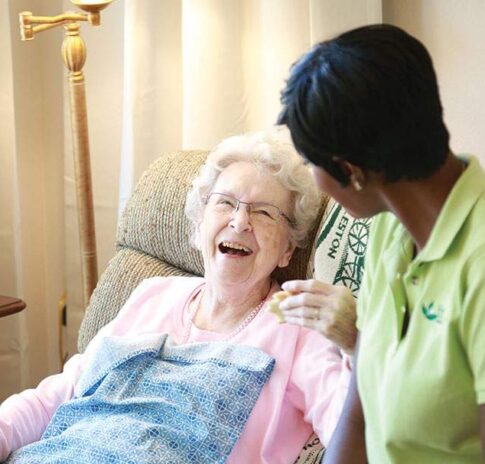Improving Quality of Life for Seniors with Alzheimer’s
Alzheimer’s is a particularly cruel disease, as it wipes away a human’s personality one day at a time until they become unrecognizable to us. And though it happens relatively frequently in seniors, almost to the point of expecting it, it still isn’t any easier to both cope or live with.
How Alzheimer’s Starts Progresses, and Ends
Over 100 years ago, in 1906, the disease now known as Alzheimer’s was first discussed by Alois Alzheimer. And today, a century after it was first described, almost 30 million people worldwide suffer from it, with the number expected to increase to 1 in 85 in only 35 years’ time.
How it works is plaques (beta-amyloid peptide, cellular material) and tangles (bunches of the protein tau) attach themselves to the brain, causing neurons and synapses in the cerebral cortex—as well as some subcortical regions—to be destroyed. This damage greatly reduces the brain’s ability to work at peak performance, as it no longer has enough neurons to complete ordinary tasks. Alzheimer’s is usually diagnosed in the 65+ demographic, although early-onset Alzheimer’s also occurs, usually with faster and more devastating effects.
Beginning
The early stages of Alzheimer’s are very easily confused with “normal” aging symptoms like mild confusion, slightly decreased memory, searching for words, and forgetting where things are, or other symptoms related to stress.
But if these symptoms persist, deviate from the norm enough, or start to interfere with daily living and activities, tests may be in order to confirm Alzheimer’s (a fully definitive diagnosis can only be performed post-mortem by examining brain tissue for an abundance of plaques and tangles). This test will usually involve the following, and is used to place the senior into one of seven stages:
- Complete medical history
- Physical tests (e.g. blood tests, brain imaging) to rule out any other possible causes
- Physical and neurological exam
- Mental status tests
How the last test is performed may vary from doctor to doctor, but they’re all checking for signs that the senior’s mental status is significantly deviant of the norm. For example, it’s normal to forget a word in the middle of a sentence, but a key characteristic of Alzheimer’s is using what seems like every other word to describe the word except the word itself, and consistently doing so.
Middle
As Alzheimer’s progresses—there is no cure—the symptoms get worse and worse, and the good days become less and less. The Alzheimer’s Association defines Stage 4, the exact middle of Alzheimer’s progression, as containing symptoms in the following areas:
- Forgetfulness of recent events
- Impaired ability to perform challenging mental arithmetic—for example, counting backward from 100 by 7s
- Greater difficulty performing complex tasks, such as planning dinner for guests, paying bills or managing finances
- Forgetfulness about one’s own personal history
- Becoming moody or withdrawn, especially in socially or mentally challenging situations
End
As seniors with Alzheimer’s reach the end of the disease spectrum, the symptoms are at their worst and cruelest. It becomes quite evident that the senior has had Alzheimer’s for quite some time as they no longer can speak or respond to their environment, have trouble swallowing, suffer from muscular rigidity, and need a great deal of assistance with day-to-day activities.
The care involved in late-stage Alzheimer’s is very specialized and high-level, as seniors need to be physically lifted out of bed, dressed, bathed and fed. Seniors also become very vulnerable to infections, such as pneumonia and bed sores, from their bodies’ muscles not reacting as they should.
Caring for Seniors with Alzheimer’s
Becoming a caregiver can be an incredibly difficult task, but also a rewarding one as you maintain a bond with your senior right up until the very end. In the beginning and middle stages, your role as a caregiver is centered on assisting your senior with mild activities, such as driving them to social activities, helping with grocery shopping and cooking, labeling drawers in the home, and attending doctor’s visits.
But as Alzheimer’s steadily progresses, your role takes on a different slant: to provide and maintain quality of life for them. Because your senior now operates on a very primal, visceral level, it’s important to engage the senses and keep a calm, soothing atmosphere.
Although it may be difficult to constantly be face-to-face with the ravages of Alzheimer’s, some activities you can do as a caregiver include:
- Playing their favorite music, as music is one of the most powerful memory triggers and soul soothers around
- Reading aloud to them so they can hear your voice, even if they can’t respond
- Cooking or baking for them, with smell being another extremely powerful memory trigger
- Performing small physical activities, like brushing their hair, rubbing lotion onto their hands, massaging their feet, legs, hands or arms (gently)
- Going for a walk or sitting outside on a nice day to feel the sun
- Pool immersion, if the pool has a special lifting device designed for physical incapacity
- Going over a photo album together
Along with these activities, another option as a caregiver is to consider hospice care for your senior. What hospice care does is focus entirely on reducing the pain and discomfort of your senior’s symptoms, and increase end-of-life quality as much as possible. To qualify for Medicare benefits for hospice care, a medical professional must officially sign off that your senior has six months or less to live. It may be a difficult decision, but the sooner you have it, the easier it is.
Guest Blogger. Jan Bolder is the lead content writer for LivingSenior.
